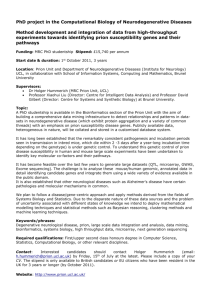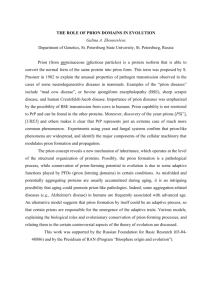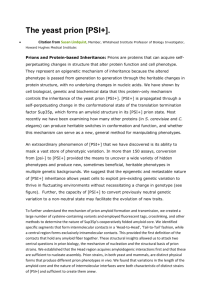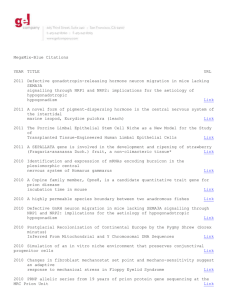Sample Extra Credit Paper
advertisement
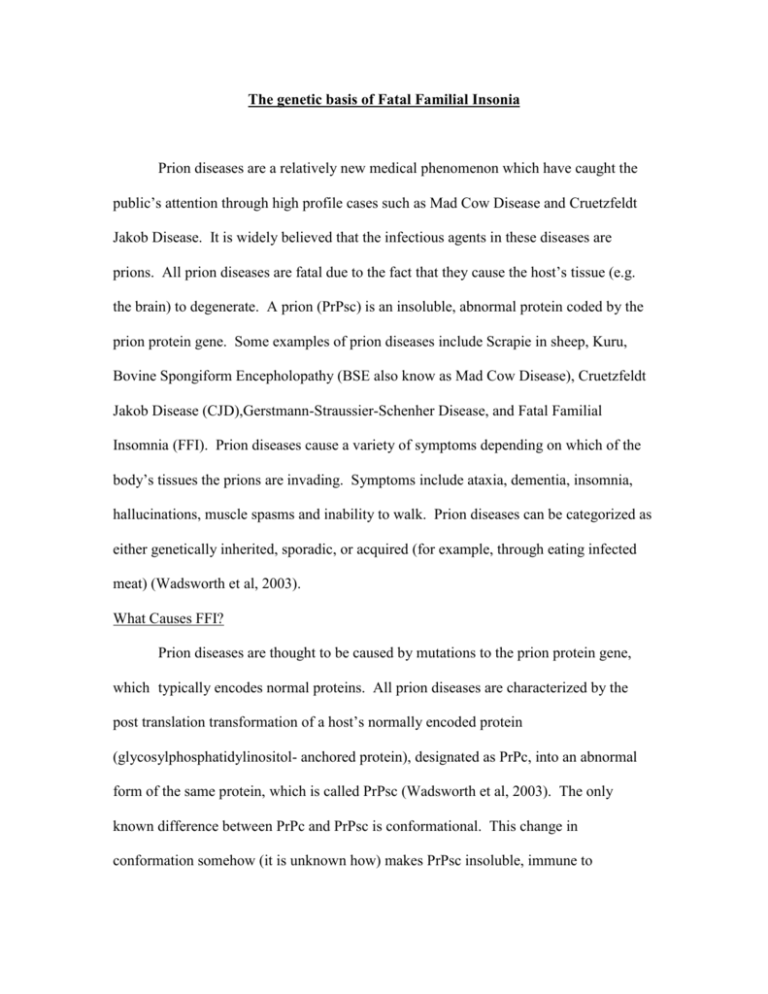
The genetic basis of Fatal Familial Insonia Prion diseases are a relatively new medical phenomenon which have caught the public’s attention through high profile cases such as Mad Cow Disease and Cruetzfeldt Jakob Disease. It is widely believed that the infectious agents in these diseases are prions. All prion diseases are fatal due to the fact that they cause the host’s tissue (e.g. the brain) to degenerate. A prion (PrPsc) is an insoluble, abnormal protein coded by the prion protein gene. Some examples of prion diseases include Scrapie in sheep, Kuru, Bovine Spongiform Encepholopathy (BSE also know as Mad Cow Disease), Cruetzfeldt Jakob Disease (CJD),Gerstmann-Straussier-Schenher Disease, and Fatal Familial Insomnia (FFI). Prion diseases cause a variety of symptoms depending on which of the body’s tissues the prions are invading. Symptoms include ataxia, dementia, insomnia, hallucinations, muscle spasms and inability to walk. Prion diseases can be categorized as either genetically inherited, sporadic, or acquired (for example, through eating infected meat) (Wadsworth et al, 2003). What Causes FFI? Prion diseases are thought to be caused by mutations to the prion protein gene, which typically encodes normal proteins. All prion diseases are characterized by the post translation transformation of a host’s normally encoded protein (glycosylphosphatidylinositol- anchored protein), designated as PrPc, into an abnormal form of the same protein, which is called PrPsc (Wadsworth et al, 2003). The only known difference between PrPc and PrPsc is conformational. This change in conformation somehow (it is unknown how) makes PrPsc insoluble, immune to breakdown by protease, and non- denaturable (its protein folding cannot be altered). Proteins exist in either globular forms (which are soluble) or fibrous forms (which are insoluble). Globular proteins, such as PrPc, must remain in their folded states, or they will not function properly. Even the slightest misfolding of a protein can cause it to convert to its insoluble form. In protein diseases the normally folded PrPc proteins are relaxed (after translation) from alpha helixes (their 3` folding structure) into beta pleated sheets (2` folding) (Dobson, 2002 & Adrian et al, 2005). This is why prion diseases can be referred to as protein misfolding diseases. It is not known exactly why the PrPc (normal) form of prion protein is soluble and its isoform, PrPsc, is insoluble in water and resistant to breakdown from protease (Dobson, 2002 & Adrian et al, 2005). The insolubility of PrPsc is the cause of neurological and other tissue damage in patients with prion diseases (Wadsworth et al, 2003). The beta pleated sheets clump together and, due to the fact that they are fibrous, build up. This kills and forms holes in the tissue where the prions are deposited. PrPsc is thought to be the primary, if not sole, disease causing agent in all prion diseases (Wadsworth et al, 2003). Abnormal prion proteins alter the structure of PrPc that they come in contact with, and it is unclear how they are capable of doing this. There has been much research focused on understanding prion diseases, but there is still no consensus in the scientific community as to how prions work, and whether or not they work alone to cause disease. However, the fact that mutations to the prion protein gene along with PrPsc product are found in all victims of prion diseases makes the theory that prions do have a significant role in causing protein misfolding diseases indisputable. Fifteen percent of all human prion cases are autosomal dominant disorders. This includes Fatal Familial Insomnia, which is one of fifty autosomal dominant mutations to PRNP (the prion protein gene) (Wadsworth et al, 2003). Gerstmann-Straussier-Schenher Disease, is another autosomal dominant disease which is similar to Fatal Familial Insomnia. FFI is caused by an inherited point mutation on the prion protein gene (PRNP). This mutation, specifically a sparagine substituting aspartic acid (GAC-AAC) (Macchi et al, 1997) on codon 178, chromosome 20, is thought to cause the normal PrPc protein to form PrPsc after translation. This mutation leads to an increase and build up of PrPsc in the brain. The abnormal PrPsc deposits in the brain tissue and causes the neurological tissue to die. This inhibits normal neurological functioning. FFI shows high penetrance, and is the third most common heritable prion disease (Montagna et al, 2003). Codon 129 is polymorphic in all people, and does not determine whether or not a person has FFI (as does codon 178), but it does determine the phenotype of the disease in FFI and CJD patients (Zarranz et al, 2005). On codon 129, 37% of the normal population is homozygous for methionine, 51% are heterozygous with methionine and valine, and 12% are homozygous for valine. People with a the characteristic FFI or CJD mutation on 178, and with the met/met homozygous polymorphism on codon 129 experience a shorter disease span of FFI with less gradual, more severe symptoms. People with the codon 178 mutation, who are heterozygous (met/val) also contract FFI, however their disease span is significantly longer, and symptoms appear less gradually. Due to the fact that the disease span is longer, post mortem biopsies often show more thalamic damage. People with the codon 129 mutation, and who are homozygous for valine are diagnosed with CJD (Plazzi et al, 2002, Spacey et al, 2002, Adrian et al, 2005, & Zarranz et al, 2005). This illustrates how closely related CJD and FFI are. It remains unknown how or why codon 129 controls the phenotypes of otherwise genetically identical mutations. The average duration of FFI is seven to thirty six months (Gordon, 2004). However, there are two forms of FFI; one with a short duration, seven to nine months on average, and one with a longer duration, twenty one to thirty six months on average (Gordon, 2004). There is no cure for FFI, and there is no effective treatment to reduce its victims’ suffering. The onset of Fatal Familial Insomnia is anywhere between the ages of 35 and 61 years (Gordon, 2004). Case studies on FFI victims have been done in China, Japan, Austria, the UK, the US, and Italy. There are 27 families known to carry the FFI gene (Montagna et al, 2003). Symptoms of FFI Not all persons suffering from FFI experience all of the possible symptoms. However, as is obvious by the name of the disease, all patients do suffer from incurable, progressive insomnia which cannot be relieved with any treatment (i.e. pharmaceuticals such as sedatives will not help reduce symptoms). Patients with FFI experience what at first would be classified as mild insomnia, but as the disease progresses they are unable to fall asleep at all, which leads to impairment of bodily functions and slowing of cognitive capacities. Patients not only experience less sleep, but also experience almost no slow wave sleep (Plazzi et al, 2002) or Rapid Eye Movement (REM) sleep when they are able to doze off (Gordon, 2004). Accordingly, many of the symptoms that FFI victims experience can be attributed to the fact that their bodies are un rested. Perhaps the most tortuous aspect of FFI is the fact that cognitive capacities are slowed down, not diminished. Case studies have shown that patients’ mental capacity remains in tact throughout the duration of the disease. In, Fatal Familial Insomnia; Clinical, Neuropathological, and Genetic Description of a Spanish Family, the authors report that one of the victims they studied had a perfect score on the mini mental state exam (Tabernero et al, 2000). Although patients cognitive capacities are slower than normal (for example they may experience inability to concentrate, and trouble with other frontal lobe functions such as planning ahead), intelligence and other high level processes, such as recognition of familiar faces, stay intact until death (Tabernero et al, 2000). It is believed that patients are incredibly exhausted, and therefore in a state of mild confusion, not true dementia (Montagna et al, 2003). Victims may die suddenly while conscious or may lapse into a coma like state and eventually die (Montagna et al, 2003). Neurological Effects Significant neuron loss in the thalamus and cerebellum is observed in the brains of FFI victims. The cerebellum is important in central nervous system functioning as well as fine motor functioning. The thalamus is important in relaying sensory information. The Thalamus is the part of the brain impacted most by FFI. PET scans of patients who have been diagnosed with FFI show reduced activity in the thalamus, and thalamus activity continues to decrease as the disease progresses. (Montagna et al, 2003). For example, glucose metabolism continues to decrease in the thalamus after the onset of the disease (Montagna et al, 2003). Although various regions of the brain are affected in FFI victims, the thalamus is the first to experience widespread neuron loss. It is believed that damage to other regions of the brain (such as the caudate nucleus and frontal lobes) are side effects of long disease duration, and that such damage does not contribute to the most conspicuous symptom FFI, insomnia. Support for this belief comes from the fact that patients who survive eighteen months or more experience significantly more widespread and nonspecific brain damage than those who die shortly after the onset of the disease (Montagna et al, 2003). “Overall, FFI can be thought of as preferential thalamic degeneration, with cortical especially limbic changes related to disease durations.” (Montagna et al, 2003). It is thought that the thalamus of FFI victims is more vulnerable to the buildup of PrPsc, but it is not known why (Montagna et al, 2003). Strangely, the occipital cortex of the brain remains unaffected throughout the duration of the disease. It is unknown why this is (Montagna et al, 2003). It is still not agreed upon in the scientific community whether or not the disruption of sleep cycles is due to thalamus specific degeneration in FFI, but this subject may prove to be an important point of research in the study of neurology and sleep disorders. Why Study FFI Cruetzfeldt Jakob Disease is the prion disease most similar to FFI. The many similarities and slight differences between FFI and CJD are good examples of how intricate and complex prion diseases are. People with FFI and CJD have identical mutations on codon 178 and experience similar symptoms. However, FFI and CJD are distinct diseases. Different polymorphs on codon 129 control whether or not the phenotype of the disease classifies as CJD of FFI (Macchi et al, 1997). Victims of both diseases experience significant neural loss. In FFI, the thalamus suffers the most damage, and in CJD damage is distributed throughout the brain and is not concentrated in the thalamus (Montagna et al, 2003). “Compared with FFI, CJD patients had more thalamic neurons preserved.” (Macchi et al, 1997). FFI typically has a longer duration than CJD (Montagna et al, 2003) and insomnia is not a hallmark symptom of CJD. CJD is caused by the same strain of prion disease that causes Bovine Spongiform Encepholopathy in cattle. Several people have contracted the disease from eating infected beef, and this has undoubtedly caught the public’s attention toward the need for prion disease awareness and research. Perhaps one of the more obvious and direct reasons for studying FFI and other prion diseases is finding a cure. Similarly, a treatment to reduce victims suffering would make death from prion diseases much more humane. Due to past research on prion diseases, FFI can now be diagnosed before the onset of symptoms by identifying pathogenic prion proteins (Wadsworth et al, 2003). A diagnosis of FFI can help those who will fall victim to the disease better plan their future. For example, a carrier of FFI might choose not to have children in order to avoid passing on the disease. There are also less obvious motivations to study prions, without direct benefits. Such motivations include scientific curiosity and the desire for acquisition of new scientific knowledge. There are so many things that remain unknown about prion diseases, as is reflected throughout this paper. The origins and mechanisms of prion diseases are unknown. There is some scientific controversy as to whether or not abnormal prion proteins are the sole infections agents in prion diseases. Some scientists are skeptical that abnormal prion proteins alone can cause such extensive damage and such a variety of phenotypic effects as are represented by the many different prion diseases. Different PrPsc proteins have unique chemical compositions, and it appears that PrPsc is affected by and interacts with the host’s genome. Further research into how such interactions function might help to explain the variety of different phenotypes displayed by prion diseases. It is not agreed upon in the scientific community what role the thalamus, or codons 178 and 129 play on sleep cycles. According to research by Plazzi et al., it does not appear that codon 178 has an effect on sleep cycles of those in the normal population. However, experiments on this subject have used small sample sizes consisting of closely related family members, so the data, although useful, should not be assumed valid (Plazzi et al, 1949). The thalamus might be involved in the regulation of hormones that control sleep cycles. Some scientists do not believe the thalamus plays a role sleep cycles while others believe that the thalamus has an important role in sleep cycle regulation. However, “The role of the thalamus in sleep regulation is unknown.” (Montagna et al, 2003). It is also unknown what makes the thalamus more susceptible to prion damage, and why some areas of the brain, specifically the occipital cortex, experience almost no neural loss. Perhaps by discovering what makes the thalamus more vulnerable to degeneration researchers can learn what will make it more resistant. It is important to study PRNP as well as FFI to gain insight into the control of sleep. Mice whose PRNP gene is knocked out cannot sleep for a prolonged periods of time (they sleep in tiny, restless increments). Those whose PRNP genes have not been knocked out experience normal sleep cycles (Montagna et al, 2003). The study of FFI and PRNP may be important to biopsychology as well as neurology and biology. If researchers can discover what mechanisms are affecting the circadian rhythms of FFI patients, this might have implications not only for FFI patients but also for less serious, but more common disorders such as insomnia. Another important aspect of sleep research and FFI is understanding the importance of rapid eye movement (REM) sleep. Most mammals, with only one or two exceptions, have REM sleep. It is thought that REM sleep, not just sleep in general, is important to survival. In cases of FFI, patients often can doze off for a few minutes but do not experience REM sleep at all. It is thought that this lack of REM sleep, not lack of sleep in general, is what makes FFI fatal. However, exactly what makes REM sleep so important to the survival of humans and most other mammals remains unknown. FFI is considered an inherited disorder, it is not an acquired prion disease. However, there have been 7 reported cases of fatal insomnia that developed sporadically (Tabernero et al, 2000). Sporadic Familial Insomnia is even more mysterious and unexplainable than FFI. Patients of SFI experience the same symptoms and neural loss as those of FFI, although in the few sporadic cases of familial insomnia, mutations on codon 178 were not present (Wadsworth et al, 2003). It is unknown how or why the victims of SFI contracted the disease. All SFI victims are homozygous for methionine on codon 129 (Montagna et al, 2003). Why this is, and how SFI works is a mystery. Fatal Familial Insomnia has been sporadically transmitted to lab animals from infected tissue (Montagna et al, 2003). This research might help scientists to better understand the mechanisms of sporadic fatal insomnia. Discovering what role codon 129 plays in CJD and FFI might also help researchers to understand SFI. FFI might also be helpful in understanding the physiology of various brain regions. There are a variety of different symptoms and brain damaged regions associated with FFI and other prion diseases. Neurologists can gain knowledge about the functions of the brain by matching areas of the brain that have been destroyed with the victims' displayed symptoms. Fatal Familial Insomnia is a complex disease, as are all prion diseases. So little is known about prion diseases and fully understanding their mechanisms will take an incredible amount of research in terms of time and money. It is important that FFI continues to be researched along with all prion diseases because such research can have serious implications for expanding scientific knowledge, and can bring about a variety of practical uses. Solving the mystery as to how prions work, and if they work alone, would have far reaching implications beyond treating those who suffer from prion diseases. Research on prions has the ability to contribute to a variety different scientific studies. Such research could contribute to neurological research, as well as aiding victims of sleeping disorders less serious than FFI such as insomnia. Prion research may also help to solve the mysteries of other diseases such as Alzheimer's, which is believed to be linked to increases in the amounts of insoluble proteins in the microtubules of neurons. Victims of Fatal Familial Insomnia experience terrible deaths. Cognitive capacities remain intact through the duration of the agonizing disease. It is painful to even imagine dying from a disease that slowly kills a person by robbing them of sleep. Even if one does not believe that FFI research has numerous scientific and clinical applications, realizing the degree of suffering a person who falls victim to FFI and other prion diseases must experience is reason enough to support prion protein research. Works Cited Apetri, A.C., Vanik, D.L., and Surewicz, W.K. (2005). Polymorphism at Residue 129 Modulates the Conformational Conversion of the D178N Variant of Human Prion Protein 90-231. Biochemistry, (44), 15880-15888. Dobson, C.M. (2002). Protein Misfolding Diseases: Getting out of Shape. Nature, 418, 729-730. Gordon, N. (2004). Fatal Familial Insomnia. J R Coll Physician Ed (34), 106108. Macchi, G., Rossi, G., Abbamondi, A.L., Giaccone, G., Mancia, D., Tagliavini, F., & Bugiani, O. (1997) Diffuse Thalamic Degeneration in Fatal Familial Insomnia. A Morphometric Study. Brain Research (771), 154-158. Montagna, P., Gambetti, P., Cortelli, P., & Lugaresi, E. (2003). Familial and Sporadic Fatal Insomnia. The Lancet Neurology, 2(3), 167-176. Plazzi, G., Montagna, P., Beelke, M., Nobili, L., De Carli, F., Cortelli, P., Vandi, S., Avoni, P., Tinuper, P., Gambetti, P., Lugaresi, E., & Ferrillo, F. (2002). Does the Prion Protein Gene 129 Codon Polymorphism Influence Sleep? Evidence from a Fatal Familial Insomnia Kindred. Clinical Neurophysiology, (113), 1948-1953. Spacey, S.D., Pastore, M., McGillivray, B., Fleming, J., Gambetti, P., & Feldman, H. (2004). Fatal Familial Insomnia; The First Account in a Family of Chinese Descent. Archives of Neurology (61), 122-125. Taberno, C., Polo, J.M., Servillano, M., Munos, R., Berciano, J., Cabello, A., Baez, B., Ricoy, J., Carpizo, R., Figols, J., Cuadrado, N., & Claveria, L. (2000). Fatal Familial Insomnia: Clinical, Neuropathological, and Genetic Description of a Spanish Family. J Neurol Neurosurg Psychiatry (68), 774-777 Wasdworth, J. Hill, A., Beck, J., & Collinge, J. (2003). Molecular and Clinical Classification of Human Prion Disease. British Medical Bulletin (66), 241-254. Zarranz, J.J., Digon, A., Altares, B., Rodriguez, A.B., Arce, A., Carrera, N., Femandez- Manchola, I., Forcadas, I., Galdos, L., Gomez-Esteban, J.C., Ibanez, A., Lezacano, E., Lopez de Munain, A., Velasco, F., de Pancorbo, M.M. (2005). Phenotypic Variability in Familial Prion Diseases due to the D178N Mutation. Journal of Neurology Neurosurgery and Psychiatry. 76(11). 1491-1496.



